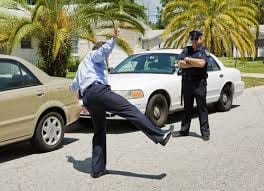 At first blush, the one-leg stand test may seem like a rather mindless exercise. The ability to stand on one leg for fifteen or so seconds may seem unrelated to the ability to drive a car.
At first blush, the one-leg stand test may seem like a rather mindless exercise. The ability to stand on one leg for fifteen or so seconds may seem unrelated to the ability to drive a car.
But there is a method to the madness. Like the Walk-and-Turn, the OLS is a divided attention test. It measures both physical dexterity and mental acuity. Scientifically, people who struggle with visuospatial attention issues (i.e. cannot walk and chew gum at the same time) are almost always intoxicated. So, the OLS may be useless when it comes to determining driving skills. But at least according to some, it speaks volumes about the test subject’s alcohol intoxication, or lack thereof.
Breaking Down the OLS
The one leg stand is one of the three NHTSA-approved field sobriety tests which officers use in DWI arrests. Officers may administer other tests as well, such as Homer Simpson’s reciting the ABCs test and the finger-to-nose test. But these test results are usually only admissible for limited purposes.
In the OLS, defendants must stand still while officers deliver test instructions. They vary slightly by department, but generally, the defendant must lift one leg and hold it at a 45-degree angle for about fifteen seconds. During the test, officers look for clues, like:
· Beginning with the wrong leg,
· Holding the leg at the wrong angle,
· Using arms for balance,
· Swaying,
· Wavering, and
· Putting down the raised leg early.
Defendants must silently count fifteen seconds, or whatever the time is, while maintaining a statute-like posture. That’s the “divided attention” part of this test.
OLS Evaluation
Typically, if the defendant exhibits more than three intoxication clues, the officer will testify that the defendant “failed” the test. But these clues are often minor technicalities, such as holding the leg at a slightly incorrect angle or an almost imperceptible sway. Most Parker County jurors would not consider these missteps to be major failures.
There is an overall concern as well. Many times, officers intentionally give incomplete instructions. They do not tell defendants how long they must hold their legs up. That’s extremely unsettling for defendants who are already in a very unsettling situation.
Finally, test conditions may play a role in the OLS. Most specifically, the surface must be as flat as a pancake. Even a slight slope can affect balance, especially after the defendant has been standing on one foot for more than about seven or nine seconds. Parking lots and streets are almost always sloped. Many times, these slopes are rather steep. Some rooms are sloped as well, especially if there is a drain in the room.
The OLS is a poor indicator of intoxication levels. For a free consultation with an experienced criminal defense attorney in Weatherford, contact Herreth Law. Convenient payment plans are available.

